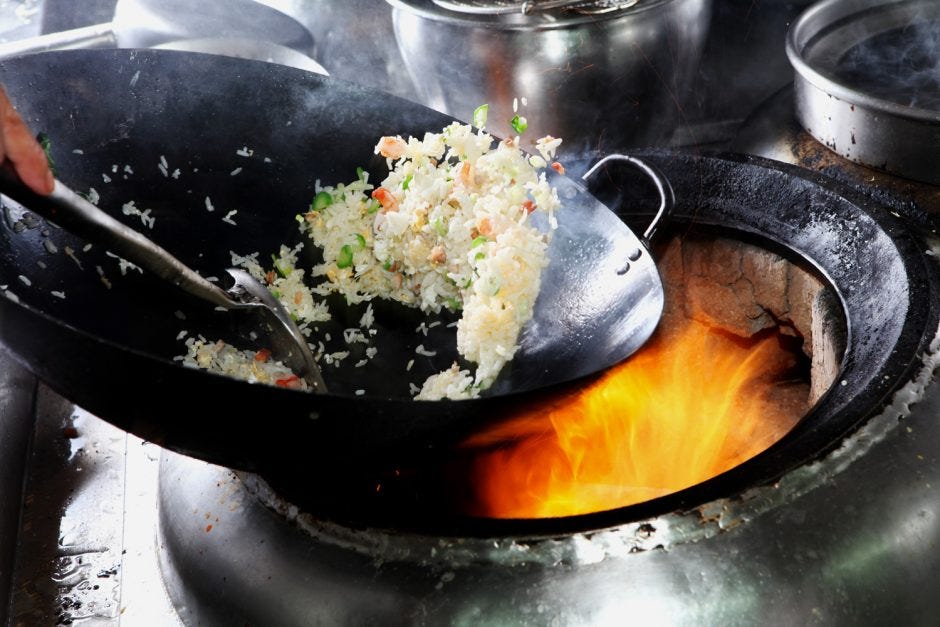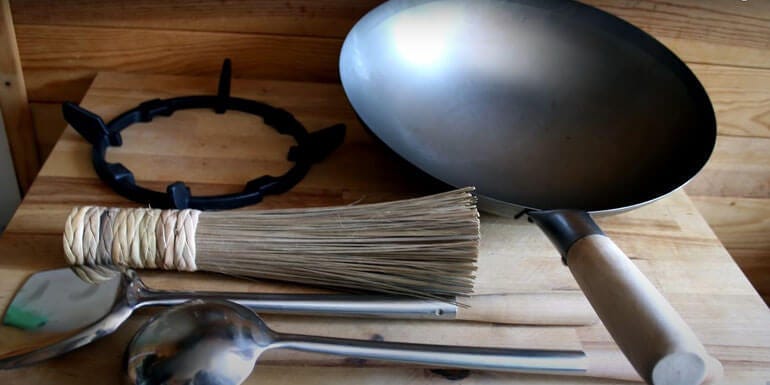Happy Chinese New Year to everyone who’s celebrating! 🍊🍊 Last week, I wrote all about the two heroes of fried rice - egg and rice. Today, we’d be talking about wok hei, the number one thing you hear when people talk about good fried rice, and how to achieve it in your home!
Wok hei, cast-iron, and carbon steel
Wok hei is Cantonese for ‘breath of the wok’, and refers to the smoky, charred flavour that you would typically get from a stir-fry at a Chinese eatery or restaurant. People tend to think that wok hei comes solely from food being scorched on extremely high heat (caramelization/ Maillard reaction), but it is primarily the flavour of polymerized oil that undergoes thermal decomposition at extremely high heat.
What is polymerized oil? When you buy a cast-iron pan or carbon steel wok, it is unseasoned. Everything that you cook sticks to it. You’ll learn that to care for your new cookware, you must never use soap on it and rub it with oil after every use. Instead, you use nothing but sponge/ stiff brush + water to clean it. This means that all the debris is lifted from your wok when you clean it, but a film of oil remains. When the cast-iron or carbon steel is heated, the oil polymerizes, becoming hard and resistant, and bonded to the metal.
Over time, more layers of oil are built on the surface, allowing it to become non-stick enough to cook an egg without sticking. The high heat that stir-frying demands also thermally decomposes the polymerized oil, imparting wok hei to the food.
Here’s how I care for my cast-iron pan after cooking:
Clean the surface with running water and a sponge (with no dishwashing liquid) to remove debris but not any oil - if you use soap, it would remove all the layers of oil that you worked so hard to build up over time.
Place on the stove on high heat and heat until any trace of water evaporates.
Rub the surface all over with some oil - this is a protective step which prevents rusting.
Because I have used my cast-iron pan for awhile now, everything I cook with it on high heat has some degree of wok hei. Heck, even after a stir-fry sometimes, my hand has wok hei! 😂 On the other hand, my enamel-coated wok produces less wok hei, because the layers of oil are unable to build as well on enamel as they would traditional cast-iron or carbon steel cookware. I hope this debunks the myth that as long as you use a wok on high heat, you’d get wok hei! So in that case, should you use a seasoned cast-iron pan to make fried rice?
The downsides of cast-iron pan
A cast-iron pan is heavy and holds onto heat, perfect for achieving a good sear on steaks because it maintains a high temperature consistently. However, with fried rice, you don’t want a consistently high temperature applied to the food:
There are times when you want to apply very high heat for oil to thermally decompose for wok hei, and for ingredients to sear and brown.
But, other times, you want lower heat as the ingredients of fried rice are far more delicate. You don’t want the eggs to be overcooked, the chopped garlic to scorch, or the rice to get crunchy.
In short, you want to be able to control the heat - be able to apply fierce heat when you need it, and tone things down at other times. With a cast-iron pan that holds onto heat for a long time (i.e. is not able to cool down quickly), the cook does not have complete heat control. The advantage of using a wok is that it is hammered thinly, thus the heat of the wok is mainly controlled by the strength of the flame beneath.
The other downside of a cast-iron pan is that it is impossible to fry a significant quantity of fried rice without making a mess. With the wok shaped like a bowl, you are able to combine all the ingredients properly without making a mess.

In an ideal world, you would have a well-seasoned carbon steel wok (promising wok hei and thin enough to absorb and dissipate heat rather quickly) + a jet engine burner that delivers an intense flame in a single jerk of the knee, but that’s not the case for most if not all home cooks.
Some folks talk about using a blowtorch to get wok hei, but I don’t own one. Plus, the flavour of blowtorched food vs wok hei that is the result of polymerized oil on your cookware is quite different.
Here’s the workaround I came up with to get wok hei at home: Fry the rice in my cast iron pan to get wok hei, before frying the more delicate ingredients (e.g. eggs and garlic) & tossing everything together in my enamel-coated wok. You can use any other non-cast-iron cookware for this, doesn’t have to be a wok. A large saucepan would work.
The rice is done when it starts jumping in the pan and tastes smoky. Once it is done, you want to remove it from the pan right away. As mentioned before, cast-iron retains heat extremely well, and if you stall, your rice will overcook in the pan and you’ll get dry, crunchy kernels 🙅🏻♀️
This newsletter is getting long, so I’m leaving the rest for another time. There’s still the idea of ‘hot wok cold oil’ to talk about and ingredients/ seasonings you can use in your fried rice! In the meantime, if you’re a member, you can start cooking from the recipe + watch the tutorial here (and sign up for our cookalong if you like). Till the next newsletter! ✨😊








